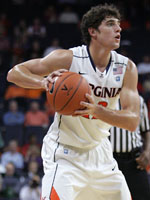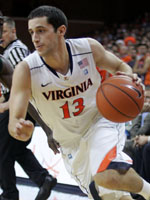 |
|
Joe Harris and the Hoos hope to pick up an ACC road win. |
After seeing a 12-game winning streak snapped at Cameron Indoor Stadium, the Cavaliers hit the road again and seek to return to their winning ways against Georgia Tech on Thursday night. But the game won’t be at the Alexander Memorial Coliseum, which is being renovated and rechristened the Hank McCamish Pavilion. Instead, the game will be held at Philips Arena, the home of the NBA’s Hawks. And, for the first time in more than a decade, we won’t be seeing Paul Hewitt roaming the sideline for the Yellow Jackets. He’s been fired and replaced by former Dayton head coach and Tom Izzo disciple Brian Gregory, who was at Michigan State for a Spartans’ National Championship, several games against Papa Bennett’s Badgers, and the basketball on ice experiment against UVa at the Richmond Coliseum in 2001. Will the Hoos be able to continue their recent success against the Rambling Wreck, one of two teams whom Tony Bennett has not lost against in his tenure at UVa?
Let’s take a closer look with a Georgia Tech primer …
1. Georgia Tech’s results on the season so far are one cause for optimism. The Yellow Jackets have a losing record on the year (8-9), and, after showing some early sting in wins against VCU (73-60) and at Georgia (68-56), they closed their out-of-conference campaign with a trio of embarrassing losses to Mercer (65-59), Fordham (72-66), and Alabama (73-48). That said, they seemed to play better in a close home loss to Duke (81-74) and a convincing win at N.C. State (82-71) before coming down to earth a bit in a 61-50 loss at Maryland on Sunday. On the season, the Rambling Wreck is No. 111 in KenPom, No. 98 in TAPE, and No. 134 in RPI.
2. Another reason to be optimistic is that the Yellow Jackets lost lots of talent from last year’s underperforming bunch. Georgia Tech’s best player last year, Iman Shumpert, who went for 19 and 12 against the Hoos, is now lacing them up in Madison Square Garden for the Knicks. Last year’s third-leading scorer, Brian Oliver , who tallied 13 points against UVa in JPJ, transferred to Seton Hall. And Maurice Miller, last year’s fifth-leading scorer, has graduated along with the 17 points he scored in the two games against Virginia. When you throw in the graduation of role player Lance Storrs , the Rambling Wreck has lost 55% of its scoring against the Cavaliers (66/120 points) from last year.
3. It is thus understandable that Georgia Tech’s offense has looked pedestrian on the year with Brian Gregory’s crew ranking No. 176 in adjusted offensive efficiency according to KenPom. In particular, the Yellow Jackets are poor at turning the ball over (No. 275 in turnovers/play), shooting 3-pointers (31.1%/No. 283) and free throws (66.6%/No. 236), and getting to the charity stripe (No. 270 in free throw attempts per field goal attempt).
Brian Gregory’s M.O. on the offensive end is a variety of set plays out of a 1-4 high set in which the point guard initiates plays several feet beyond the 3 point-line while the other four players form a horizontal line at the free throw line, with two players at the opposite edges (“elbows”) of the free throw line and the other two just outside of the 3-point line. The other four players then have the option of engaging in a variety of moves and setting a variety of screens as the offense is in constant motion (you can see Gregory giving a couple of examples by clicking here). The goal seems to be to hook the defense out of the lane to set up post players. The problem for the Yellow Jackets is that the Pack Line likely isn’t going to take the bait. Gregory’s team also likes to push the ball up the court in transition offense, but Coach Bennett’s de-emphasis on offensive rebounding and emphasis on transition defense should neutralize this part of the attack.
 |
|
Sammy Zeglinski will try to get back on track at GT. |
4. Like Tom Izzo’s Spartan squads, Gregory’s Yellow Jackets are better on the defensive end, ranking No. 68 in adjusted defensive efficiency and No. 56 in defensive redounding percentage. Coach Gregory favors what he dubs the “Commando Defense”; one of its key features is to deny the ball to the opposing point guard or at least make him bring it the length of the court against the opposing point guard, who marks him the second a shot is taken. You can read all about this defense (and the “shallow triangle”) by clicking here. I won’t explain this aspect of the defense in more detail here because I didn’t see the Jackets “go Commando” at all against Maryland, and I’m guessing that Gregory fears his team isn’t ready to implement it yet and would get caught with their pants down if they tried it at this point. Besides, it would seem counterproductive to try it against the Hoos when they can have 2/3 of Jontel Evans , Sammy Zeglinski, and Malcolm Brogdon on the court at the same time with the ability to initiate the offense or bring the ball up the floor.
What that leaves is Georgia Tech’s halfcourt defense, which is a containment man-to-man scheme that is designed to slow down the opposing team’s offense rather than force turnovers (the Yellow Jackets are No. 294 in opponent turnovers per play). Coach Gregory likes to have his players hedge quite a bit on screens, which is probably best illustrated by a Dayton basketball article asking whether a change to the Archie Miller regime will end “the constant hedging of screens out to 45 feet.” The lack of pressure defense plays right into the hands of the UVa offense, and Tech’s constant hedging could create some nice mismatches for the Cavaliers.
5. Lineup:
PG: Manning the helm for the Yellow Jackets is No. 0 Mfon Udofia , a 6’2″, 193-pound junior, who, like Evans, is primarily known for his defense. Like Evans, he’s not much of an outside shooter (40.7% from the field, 31.6% from 3) and gets most of his 10.8 points per game on drives to the basket. While some of those drives lead to dishes (2.5 assists/game), many also lead to turnovers (2.8 turnovers/game), and those that lead to foul shots are not guaranteed points (68% from the line).
SG: No. 23 Brandon Reed, a 6’3″, 180-pound redshirt sophomore, starts at the “2” for the Rambling Wreck, two years removed from a transfer after a promising freshman campaign at Arkansas State. Reed has athleticism to spare and, like Udofia, is a good defender, but, in the end, he’s a shooting guard who can’t shoot. He’s only 35.7% from the field, 27.9% from long range, and 64.1% from the line on the year. Combine that with a 1.2-2.2 assist-turnover ratio, and you can see why the Yellow Jackets have had trouble scoring.
SF: One spot where Georgia Tech hasn’t struggled to score is at the “3” where No. 41 Glenn Rice Jr. (son of former NBA player Glen Rice), a 6’5″, 206-pound junior swingman, is technically not the starter, coming off the bench in the last four games. That said, he’s getting the lion’s share of the minutes for the Yellow Jackets at the “3” spot (30.1 minutes per game) and leads the team in points (13.8), shots (10.4), rebounds (6.6) and steals (1.6) per game. He’s an efficient, athletic scorer, shooting 50.3% from the field, many on drives to the basket as his outside game isn’t great (33.3% from 3). Those drives, though, lead to 2.4 turnovers per game. Last year, the Pack-Line defense held Rice to a total of 7 points on 3-of-16 shooting in the two games, but he is significantly improved this year.
PF: Starting at the “4” for the Yellow Jackets is No. 24 Kammeon Holsey, a 6’8″, 226-pound sophomore that sports something approximating a “Buddy Christ” tattoo on his right shoulder. Holsey is as good from the field (63.9%) as he is bad from the free throw line (41.5%), which makes sense because most of his scores come from within a few feet from the basket. Holsey is an athletic “4” who is more of a garbage man than a power post, which should pose problems against glass cleaner Mike Scott and the UVa defense. It certainly did last year when he tallied only 4 points on 2-5 shooting against Virginia in Atlanta after missing the game at JPJ. Foul trouble has limited Holsey to 22.4 minutes/game.
C: Down low, No. 5 Daniel Miller, a 6’11”, 258-pound sophomore starts at center for Georgia Tech. Like Assane Sene , defense is Miller’s calling card, and he’s especially skilled at blocking shots (2.8/game). He’s also solid on the boards (6.6 rebounds/game) and has a developing offensive game that has yielded 8.3 PPG on 47.2% shooting. Miller, though, is not an intimidating offense player who can push Sene around, and I expect the two centers to neutralize each other on the offensive end.
Other Key Players:
SF: As noted, Glen Rice Jr. hasn’t been starting at the “3” with that honor instead going to No. 14 Jason Morris, a 6’5″, 210-pound sophomore, who averages 24.5 minutes per game. Morris is a terrific athlete and defender and is pitching in a sturdy 8.9 points per game. As with many other Yellow Jackets, though, he’s not a great shooter from the field (38%) or long range (32%). Last year, Morris played quite well against Virginia and posted 10 points on 3-6 shooting in Atlanta and 6 points on 3-5 shooting at JPJ.
PF: When Holsey goes to the bench, he’s often replaced by No. 1 Julian Royal, a 6’7″, 230-pound freshman and former teammate of future Hoo Evan Nolte at Milton. Royal seems a lot like Darion Atkins . He’s an excellent athlete and defender who is just starting to scratch the surface of his potential on the offensive end. He averages 3.7 points and 2.2 rebounds in 13.2 minutes per game.
6. Sabre poster 504-C Brandon predicts the game as a 56-53.8 UVa win with the Hoos having a 58% chance of winning. The Team Rankings Simulation has it as a 58.6-53.6 UVa win.
Personally, I think that these margins are a bit too low. The best defenses that Georgia Tech has faced were Alabama (No. 5) and LSU (No. 21), two teams that held the Jackets to 48 and 50 points, respectively. I see UVa’s No. 8 defense stifling the Georgia Tech offense, which won’t be able to score in transition, won’t be able to penetrate the Pack-Line, won’t be able to back down the posts, and won’t be able to hit outside shots. Meanwhile, Tech’s slow-down defense plays right into Virginia’s hands, and I think the Hoos will see some more shots start to drop on Thursday, especially if Sammy Zeglinski finds his groove. I will give the Hoos the edge 62-49.



